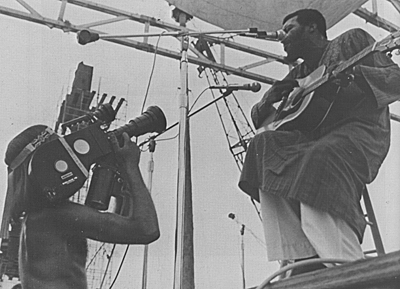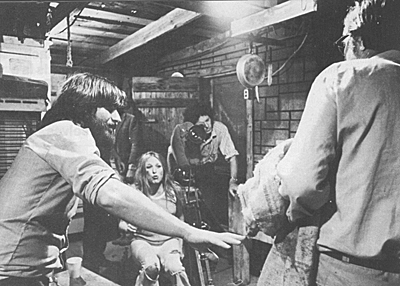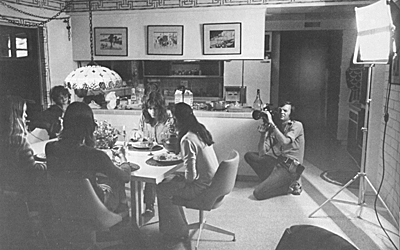Woodstock
 For me, the one film that embodies the use of the Eclair NPR is Woodstock. Made in the Summer of 1969, it was directed by a 26 year old filmmaker named Michael Wadleigh, seen here shooting Richie Havens, the very first act to appear at the festival. Besides Wadleigh, there were four other 2-person Eclair NPR camera crews shooting on the stage over those four days from August 15th to the 18th. They included Richard Pearce, Don Lenzer, Chuck Levy, Richard Chew, Ted Churchill and Ed Lynch.
For me, the one film that embodies the use of the Eclair NPR is Woodstock. Made in the Summer of 1969, it was directed by a 26 year old filmmaker named Michael Wadleigh, seen here shooting Richie Havens, the very first act to appear at the festival. Besides Wadleigh, there were four other 2-person Eclair NPR camera crews shooting on the stage over those four days from August 15th to the 18th. They included Richard Pearce, Don Lenzer, Chuck Levy, Richard Chew, Ted Churchill and Ed Lynch.
Each camera was equipped with an Angenieux 9.5 to 95mm zoom lense. Michael Wadleigh, who was the center most cameraman, also had a 5.9mm wide angle lens on his NPR for special shots. To keep the stage cameras in sync, each was fitted with an 110v synchronous motor and connected to the AC current via a cable. This meant all cameras were automatically running at the same 24fps speed referenced to the 60hz. line frequency. The same 60hz. signal was layed down as one of the tracks on the eight channel recorder used to record the stage event sound. This would allow the music to be transferred to magnetic film in sync with the picture for editing on one of several enormous three screen, German made, Amandus Keller flatbed editing machines. Their name would later be changed to KEM for Keller-Elektro-Mechanik.
Eastman ECO 7255 was used almost exclusively for the stage shooting and pushed two stops in development to ASA 100. In addition, several other crews were shooting coverage of the people who attended the event. All told, some 120 hours of 16mm film was exposed. Editing of the film would take months, with the end result being a 35mm blowup for theatrical projection. An interesting side note, here. Havens was the only performer who would not agree to be part of the movie, prior to the event. It was only months later that he finally relented. His "Freedom" song, created on the spot to stretch for more time until the next act was ready to go on, is one of the defining moments of the entire film.
Information and photograph gathered from American Cinematographer Magazine, © 1970
The Texas Chainsaw Massacre
The Texas Chainsaw Massacre was released in October of 1974, more than a year after principle photography was completed. A low budget film, even by 1970's standards, the film would go on to make millions and eventually end up in the Museum of Modern Art's permanent collection. Location shooting took thirty two days from mid August to mid July, 1973. Conditions were horrible with the heat during the day in Round Rock, Texas getting to 104 degrees. Injuries on set were commonplace but cast and crew stuck with it. A testament to their independent filmmaking spirit.
 Eastman Ektachrome 7252, which replaced 7255 in 1970, was used throughout. A slow speed, fine grain tungsten reversal film made for direct printing, it would be blown up to wide-screen 35mm for release to the theaters. Although Super 16 had been invented by then, the film was shot with unmodified Eclair NPR's. Director of Photography, Daniel Pearl (center behind camera), describes how he photographed the film. "We had two Eclair NPR's on TCM because they were the ideal camera for our frequently handheld style. Ours were not Super 16. They were standard 4:3 with Kodak Wratten 85 (translucent but orange colored) 1.85 mattes I cut and placed directly on the groung glass to allow for precise composing in the letterbox format. Daniel Pearl, ASC."
Eastman Ektachrome 7252, which replaced 7255 in 1970, was used throughout. A slow speed, fine grain tungsten reversal film made for direct printing, it would be blown up to wide-screen 35mm for release to the theaters. Although Super 16 had been invented by then, the film was shot with unmodified Eclair NPR's. Director of Photography, Daniel Pearl (center behind camera), describes how he photographed the film. "We had two Eclair NPR's on TCM because they were the ideal camera for our frequently handheld style. Ours were not Super 16. They were standard 4:3 with Kodak Wratten 85 (translucent but orange colored) 1.85 mattes I cut and placed directly on the groung glass to allow for precise composing in the letterbox format. Daniel Pearl, ASC."
In 2014, the film was released in a new 4K version. This time, the original A&B camera rolls were scanned using the ArriScan film scanner, allowing for image detail to be captured that was not possible from scanning the old prints. Dirt, scratches, bad splices and film defects were painstakingly repaired, but the film still retains it's original gritty look and feel. This version is well worth your time to watch, even in standard definition. The pristine image quality and will fool most into thinking the original camera format was 35mm, and it was not. A great example of how modern digital technology can enhance analog camera film, bringing out the best of both. This is all the more incredible when you consider one third of the 16mm film image was lost by cropping for the 1.85 matte during shooting.
Photograph © 1986, Cinefantastique magazine. Special thanks to Mr. Pearl, for his comment.
An American Family
For seven months, from May until December 1971, the young husband and wife filmmaking team of Alan and Susan Raymond and camera assistant Tom Goodwin, followed the day to day exploits of the Loud family of Santa Barbara, California. With a $1.2 million dollar budget
from PBS, they would expose some one thousand 400' rolls of Eastman EF 7242 reversal film stock.  Taking a cinema verite approach to the project, the filmmakers provided no direction or input to the seven family members. Much of the shooting took place at the family's home and at locations around the city of Santa Barbara. There were also some side trips out of state to film Bill Loud, the father, on business trips. The series consisted of twelve, one hour episodes airing on PBS stations from January until March, in 1973.
Taking a cinema verite approach to the project, the filmmakers provided no direction or input to the seven family members. Much of the shooting took place at the family's home and at locations around the city of Santa Barbara. There were also some side trips out of state to film Bill Loud, the father, on business trips. The series consisted of twelve, one hour episodes airing on PBS stations from January until March, in 1973.
All the film was pushed one stop and post flashed to reduce the contrast and bring out details in the shadow areas at CFI in Hollywood. The filmmakers chose not to dress the house with additional lighting beyond swapping out the regular incandescent bulbs in the light fixtures for 500 watt photoflood lamps. Alan shot using only a single Eclair NPR (seen kneeling right with camera) with an Angenieux 12-120mm zoom while Susan used a Nagra IV (Susan can just be seen left in the picture near the doorway) mainly with a Sennheiser 805 shotgun microphone to record location sound. The Eclair was fitted with a Beala sync motor so no cables were needed between camera and recorder. For larger areas, like the kitchen, a Lowel 2K softlight was necessary to raise the light level.
From Wikipedia, "The groundbreaking documentary is considered the first "reality" series on American television. It was originally intended as a chronicle of the daily life of the Louds, an upper middle class family in San Barbara, California but ended up documenting the break-up of the family via the separation and subsequent divorce of parents, Bill and Pat Loud."
In 2002, An American Family was listed at #32 of TV Guides 50 greatest TV shows of all time. In 2012, HBO produced Cinema Verite, a drama based on the behind the scenes of the making of An American Family. The Raymonds continue to produce documentaries to this day. They have so far garnered some twelve Emmy Awards and an Academy Award for their work.
Information and photograph gathered from American Cinematographer Magazine, © 1973

